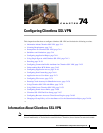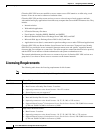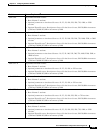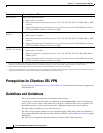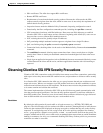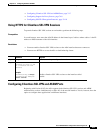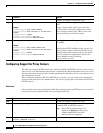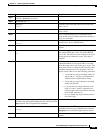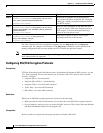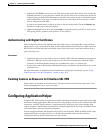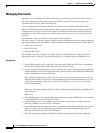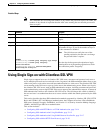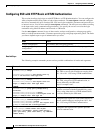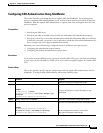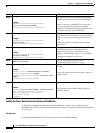
74-9
Cisco ASA 5500 Series Configuration Guide using the CLI
Chapter 74 Configuring Clientless SSL VPN
Using SSL to Access the Central Site
Step 4
https-proxy host [port] [exclude url] [username
username {password password}]
Step 5
http-proxy pac url
Step 6
(Optional)
exclude
Excludes URLs from those that can be sent to the
proxy server.
Step 7
host
Provides the hostname or IP address for the external
proxy server.
Step 8
pac
Proxy autoconfiguration file downloaded to the
browser that uses a JavaScript function to identify a
proxy for each URL.
Step 9
(Optional, and only available if you specify a username)
password
Accompanies each proxy request with a password to
provide basic, proxy authentication.
Step 10
password
Sent to the proxy server with each HTTP or HTTPS
request.
Step 11
(Optional)
port
Provides the port number used by the proxy server.
The default HTTP port is 80. The default HTTPS
port is 443. The ASA uses each of these ports if you
do not specify an alternative value. The range is
1-65535.
Step 12
url
If you entered exclude, enter a URL or a
comma-delimited list of several URLs to exclude
from those that can be sent to the proxy server. The
string does not have a character limit, but the entire
command cannot exceed 512 characters. You can
specify literal URLs or use the following wildcards:
–
* to match any string, including slashes (/)
and periods (.). You must accompany this
wildcard with an alphanumeric string.
–
? to match any single character, including
slashes and periods.
–
[x-y] to match any single character in the
range of x and y, where x represents one
character and y represents another character
in the ANSI character set.
–
[!x-y] to match any single character that is
not in the range.
Step 13
If you entered http-proxy pac, follow it with http:// and type
the URL of the proxy autoconfiguration file. (If you omit the
http:// portion, the CLI ignores the command.)
Step 14
(Optional)
username
Accompanies each HTTP proxy request with a
username for basic, proxy authentication. Only the
http-proxy host command supports this keyword.
Step 15
username
Sent to the proxy server with each HTTP or HTTPS
request.
Command Purpose



